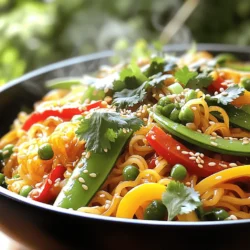Craving an explosion of flavors? You’ve come to the right place! In this post, I’ll guide you through making Spicy Szechuan Noodles that are both bold and easy to whip up. With just a few simple ingredients, you can bring the taste of Szechuan right to your kitchen. Get ready to impress your friends and family with a dish that’s sure to pack a punch! Let’s dive into the recipe!
Ingredients
List of Ingredients
- 8 oz spaghetti or rice noodles
- 2 tablespoons vegetable oil
- 3 garlic cloves, minced
- 1 thumb-sized piece of ginger, grated
- 2 tablespoons Szechuan peppercorns, toasted and crushed
- 2 tablespoons chili paste (adjust for spiciness)
- 2 tablespoons soy sauce (low sodium recommended)
- 1 tablespoon rice vinegar
- 1 tablespoon sugar
- 1 cup bell peppers, julienned (red, yellow, or green)
- 1 cup snow peas, trimmed
- 3 green onions, chopped
- Sesame seeds for garnish
- Fresh cilantro for garnish
To make the Spicy Szechuan Noodles, gather these ingredients first. You need fresh items for the best taste. The noodles can be spaghetti or rice noodles based on your choice. I love using rice noodles for a more authentic flavor.
Next, you need a mix of aromatics. Garlic and ginger make the dish pop. Szechuan peppercorns are unique and give a special zing. They add a gentle numbing heat.
Chili paste is key to the spice level. You can adjust it to fit your heat preference. Low sodium soy sauce keeps the dish balanced without too much salt. Rice vinegar adds a nice tang, while sugar helps to balance the heat.
Finally, colorful veggies like bell peppers and snow peas add crunch. Green onions, sesame seeds, and cilantro make great garnishes. They give the dish a fresh look and taste.Keep these ingredients handy, and you will create a dish that impresses everyone!
Step-by-Step Instructions
Cooking the Noodles
Start by bringing a large pot of salted water to a boil. This salt adds flavor to the noodles. Once the water is boiling, add 8 oz of spaghetti or rice noodles. Cook them according to the package instructions. Drain the noodles when done, and save some pasta water. This water can help if the sauce needs adjusting later.
Preparing the Sauce
In a bowl, mix together 2 tablespoons of soy sauce, 1 tablespoon of rice vinegar, 1 tablespoon of sugar, and 2 tablespoons of chili paste. You can adjust the heat by adding more chili paste if you want. This sauce gives the noodles their bold flavor.
Sautéing Aromatics and Vegetables
Heat 2 tablespoons of vegetable oil in a large skillet over medium heat. Add 3 minced garlic cloves, 1 thumb-sized piece of grated ginger, and 2 tablespoons of crushed Szechuan peppercorns. Sauté these for 1-2 minutes until they smell great. Be careful not to burn them. Next, add 1 cup of julienned bell peppers and 1 cup of trimmed snow peas to the skillet. Stir-fry for about 3-4 minutes, until the vegetables are bright and still crisp.
Combining Noodles and Sauce
Now, it’s time to bring everything together. Add the cooked noodles to the skillet with the sautéed vegetables. Pour the sauce over the noodles and vegetables. Toss everything gently to combine. If the mixture seems dry, add a bit of the reserved pasta water. This helps achieve the right consistency.
Garnishing and Serving
Once everything is heated through, remove the skillet from the heat. Finish the dish with chopped green onions, sesame seeds, and fresh cilantro for extra flavor and color. Serve the spicy Szechuan noodles while hot. Enjoy the bold and flavorful taste that brings Szechuan cuisine right to your table!
Tips & Tricks
Achieving the Perfect Balance of Flavors
To make your Szechuan noodles stand out, you must balance flavors well. First, adjust the spiciness with chili paste. Start with two tablespoons, then taste. If you like it hotter, add more chili paste a little at a time. This way, you control the heat without overpowering the dish.
Next, balance sweetness with sugar. The sugar helps tone down the spice a bit. Try one tablespoon first, and taste again. If the dish feels too spicy, a pinch more sugar can help. This balance makes the noodles delicious.
Cooking Tips for Texture
Choosing the right noodle is key for great texture. I recommend using spaghetti or rice noodles. Spaghetti gives a nice chew, while rice noodles absorb flavors well. Whichever you choose, cook according to package instructions for the best results.
When it comes to vegetables, keep them crunchy. I use bell peppers and snow peas for color and crunch. Stir-fry them for just a few minutes. You want them vibrant and slightly tender, not mushy. This way, they add a nice bite to your dish.
Presentation Suggestions
To make your Szechuan noodles look restaurant-worthy, focus on garnishing. After plating, sprinkle some chopped green onions on top. They add color and a fresh taste. Next, add a dash of sesame seeds for crunch.
Lastly, a few sprigs of fresh cilantro enhance the look and flavor. This simple touch makes your meal pop.

Variations
Vegetarian Version
You can easily make this dish vegetarian. Swap the meat for tofu or mushrooms. Tofu adds protein and absorbs flavors well. Use firm tofu for a nice texture. Sauté it until golden for extra taste. Mushrooms give a rich, umami flavor. Shiitake or portobello work wonderfully here. Both options keep the dish bold and satisfying.
Gluten-Free Option
For a gluten-free version, choose rice noodles and tamari. Rice noodles are light and cook quickly. They absorb the spicy sauce well. Tamari is a great substitute for soy sauce. It has a similar flavor but is gluten-free. This option keeps the dish tasty for those avoiding gluten.
Spicy Szechuan Noodles with Proteins
Want to add more protein? Chicken, beef, or shrimp are excellent choices. Thinly slice the chicken or beef for quick cooking. Cook meat until browned and add it to the stir-fry. Shrimp cooks fast and adds a sweet flavor. This variation makes the noodles even heartier. Each protein option brings its own unique taste.
Storage Info
Storing Leftovers
To keep your spicy Szechuan noodles fresh, place them in an airtight container. This helps prevent drying out. Refrigerate the noodles within two hours of cooking. They will stay good for up to three days. When ready to eat, check for any signs of spoilage. If they look or smell off, it’s best to discard them.
Reheating Instructions
When you’re ready to enjoy leftovers, there are a few good ways to reheat them. The best method is using a skillet. Heat a bit of oil over medium heat. Add the noodles and stir them well until hot. This method helps keep the flavors strong and the texture nice. You can also use the microwave. Place the noodles in a bowl, cover with a damp paper towel, and heat for one to two minutes. Stir halfway through for even heating.
Freezing Options
If you want to save some noodles for later, freezing is a great choice. First, let the noodles cool completely. Then, transfer them to a freezer-safe bag. Remove as much air as possible before sealing. They can last up to three months in the freezer. When you’re ready to eat, thaw them overnight in the fridge. Reheat them using the methods mentioned above for the best taste and texture.
FAQs
What are Szechuan noodles?
Szechuan noodles are a spicy dish from China. They feature bold flavors and a mix of textures. You usually find them stir-fried with colorful veggies and a spicy sauce. The unique taste comes from Szechuan peppercorns, which give a numbing heat. You can use spaghetti or rice noodles for a great bite.
Can I make this recipe ahead of time?
Yes, you can prepare Szechuan noodles ahead of time! Cook the noodles and veggies, then store them separately. Keep the sauce in a jar for easy access. When you are ready, heat everything in a pan. This method saves time on busy days.
What can I substitute for Szechuan peppercorns?
If you don’t have Szechuan peppercorns, you can use alternatives. Crushed red pepper flakes add heat but lack the unique flavor. You can also try black pepper or allspice for different tastes. Just remember, these substitutes will change the dish’s character a bit.
How can I adjust the spiciness of the dish?
Adjusting the spice level is easy! Start with less chili paste in the sauce. Taste and add more if you want more heat. You can also add sugar to balance the spice. If it gets too hot, add a splash of vinegar to cut the heat. Enjoy the heat just the way you like it!
This recipe for Szechuan noodles combines flavorful ingredients and simple steps. You can cook the noodles, prepare a tasty sauce, and sauté fresh veggies in no time. Adjust the spice and sweetness to suit your taste. Consider the variations for vegetarian or gluten-free options. Proper storage ensures your leftovers stay delicious. Enjoy these noodles as a quick weeknight meal or a fun dish for friends. Happy cooking!


